Second hand product, in excellent conditions, with original box, 1-year warranty.
Lavardin Technologies Model ISx Integrated Amplifier
Red Front finish
The Model ISx is a full width design with unrivaled Lavardin Technology, build quality and design philosophy, in particular the circuits and components which virtually eliminate the effects of memory distortion.
The new X circuits brings a major improvement on transparency and micro dynamics over its predecessor the Model IS.
The Model ISx will definitely bring you closer to the music and give you a purity and clarity that no other amplifier,even those far outside its price range, can achieve.
Its extreme transparency, over the full bandwidth is in contrast with midband focused transparency of the best tube amplifiers.Its micro dynamics, never aggressive, clumsy or confused is in contrast with almost all transistor and digital amplifiers.
By design, Lavardin Technologies amplifiers are the less load sensitive amplifiers ever made.Consequently, virtually all speakers will be driven at their best what ever their size and technology.This fantastic power handling allows to measure over 104W per channel on 2 ohm loads out of the Model ISx and 50w on 8ohm.
Optional features:
ZERO SIDE EFFECT VOLUME CONTROL
Today's digital sources musical drama is the use of their digital volume control, remote controled or not. It simply destroys the musicality what ever the price of the DAC, server or computer.Now, for a much better sound, simply set both DAC and computer at full level and set the volume thanks to the Lavardin amplifier remote handset.
MM PHONO INPUT
To get the full magic of vinyl reproduction, Model ISx can be fitted with our exceptional internal phono moving magnet input module.
The direct connection to the heart of the amplifier guaranties better sonic results thant any external devices.
BYPASS INPUT
For integration of a Surround Processor into High End Audio System, Model ISx can have an optional BYPASS input (input 1) with fixed amplification fitted.
For ultimate quality, both AV and stereo signals are routed directly without any additional bypass switch.
RED OR BLACK FRONT FACE AT YOUR CHOICE, please contact us prior to ordering to verify it's in distributor stock
|
Memory Distortion
an exclusive and revolutionary concept which radically pushes audio forward
Lavardin Technologies designs and manufactures high end audio amplifiers using exclusive and revolutionary design concepts which radically reduce what we have named the "Memory distortion" of components.
The memory distortion (1) of components is the greatest discovery in analog audio design over the last twenty years. It clearly demonstrates the reasons why a good valve amplifier can beat its solid state counterpart hands down for sheer musical enjoyment.
Memory distortion is the property that is the dominant factor in causing solid state amplifiers to sound shrill and mechanical. Tube technology allows electrons to travel through a vacuum which leaves no storage or memory effect, but solid-state amplifiers use silicon components which keep a trace of current flow that has gone through.
New electron flow is continuously affected by the pattern of the immediately preceding electron flow. As soon as the memory effect of these solid state circuits is reduced, all the improvements that transistor technology brings, such as high output power, accuracy, very low harmonic distortion and extended and linear frequency response, can be added to the most alive and silky musical rendition of the best single-ended monotriode designs.
This may not sound very new: some manufacturers claim to combine valve smoothness with the muscle of solid state power by using hybrid designs. As a result, they only combine the memory distortion of solid state with the limited bandwidth and distortion capability of valves.
This discovery at Lavardin Technologies demonstrates that the classic measurements made all over the world for the last decade are meaningless when considering the musical quality of an amplifier. In fact, when fixed frequency or fixed level test signals are used, it is not possible to detect remnant "memory" signals. Fixed frequency or fixed level signals may occur for less than 0.01% of the duration of any classical piece of music!! We do not believe that good sounding audio amplifiers should be designed to be perfect for 100% of the test time and only for 0.01% of the actual time they are reproducing music !!!
The Model IT integrated amplifier rated by many to be the FINEST AMPLIFIER EVER MADE, irrespective of price or technology, is the result of more than 8 years research on the memory effect of electronic components used in audio circuits designs.
Lavardin Technologies is proud to introduce this innovative concept to push audio radically forward. It breaks new ground in music reproduction. To hear a Lavardin once is a great experience: the music sounds natural, clear, fast and smooth, and never mechanical. This means that no other amplifier can be considered "the standard" any more.
TECHNICAL CORNER
What does memory distortion exactly mean?
Memory distortion is a new concept in distortion process analysis. Usual concepts of distortion are based on a very simple distortion model which does not tally with the real behaviour of electronic circuits. In the classic theoretical model of distortion, distortion of a non selective circuit results from its band limitations for linear distortion and from its non-linear transfer function for non-linear distortion. This model is a good approximation for audio circuits. But for highest quality audio it is too simplistic. It results from a tonal approach to circuits for design and measurement.
The tonal approach is very important and can be done accurately, but it ignores time; and musical flow is a key issue. That means that the classic approach to distortion measurements are valid only for time independent systems. However, the main difference between noise and music IS organisation in time.
Audio circuits are not independent of time. A detailed analysis of their behaviour with non-stationary signals reveals many changes in their characteristics. The amplitude of these changes is generally low, and these changes remain hidden by stationary signals. This is the reason why they cannot be detected with classic (and tonal) measuring systems and are thus ignored by audio designers. The amplitude of these changes, however, is often great enough to be easily audible in high quality audio systems.
That is the reason why listening tests with these systems do not tally with the usual measurements. These measurements are not able to characterise the behaviour of the circuits for musical signals in the time domain. They aim to measure THE transfer function, but they only measure ONE of the transfer functions - those which correspond to stationary signals. Most audio system are designed to be perfect for sine waves, but these are a very limited part of the total audio signal. These changes in circuit characteristics are linked to the signal itself, but not in real time, which leads to our new and exclusive concept of memory distortion.
Memory distortion occurs each time that the dynamic behaviour of a system is different from its static behaviour. If there is no memory distortion, then static and dynamic behaviour are similar and classic (static) measurements are valid. This is the secret of "tube sound". We are proud at Lavardin Technologies to have full control over that which remains "The mystery of tube musicality" for previous audio designers.
READ MORE
HiFi News
AES 100th Convention 1996 May
Diapason
Frequently Asking Question
Are Lavardin Technologies amplifiers capable to drive difficult loads ?
Thanks to their unique circuit design, our amplifiers are certainly the less load sensitive amplifiers ever made. This does not mean one could drive 1ohm speakers at max power for a techno music party all night. It means that the amplifier handles load, voltage, current and phase changes versus frequency better than any other design. This is the most important factor for quality.
Thus driving non linear or low impedances even in the critical treble area is not a problem at all. (recommended speaker impedance remains 4-8ohm).
What kind of speakers is the best match ?
Any GOOD speaker will suit. But don't expect the amplifier to balance any defect of the speakers. Bright speakers will remain or appear bright, just the way they are and they always where. To our point of view, choosing speakers and/or amplifiers in order to balance their defects is certainly not the best way to quality : "when the Pizza has too much salt, putting sugar in it will not really "improve"....
Our experience showed us that good speakers can be small or large, expensive or not, full band floorstanders or bookshelf : exactly like the ones that should not be bought. Meanwhile, two things seem constant : extremely high or low efficiency speakers seem to have gained these caracteristics for other reasons than for ultimate sound quality. This also apply to very low impedance speakers using classical round drive units....
Lavardin Technologies amplifiers is the natural choice when it is about driving very demanding transparent and revealing speakers like QUAD ESL, Magnepan, Orthophase, ...
Incredible results are also obtained when driving classical reference speakers like Avalon OPUS (non ceramic), Rogers LS3/5A, Sonus Faber Guarnery Homage, JMLab UTOPIA series, ASA Monitor and many others ..... From amazingly low to blasting high levels the unique fluidity and lucidity our technology allow is delivered, from the deapest bass to the highest treble. If any, this is the only Lavardin Technologies "signature".
My speakers are too bright, what can I do ?
This is one of the big problem of today's speakers. A brighter speaker will appear "more clear", "more open" and "more detailed" than its competitors, thus it will sell more. More and more customers have dull amplifiers (poor design tube amplifiers) : bright speakers will help to balance the sound. Now, what ever the reason, if is it too bright something has to be done to improve the situation. You can try these suggestions, one by one to identify the most interesting ones in your particuliar context.
ELECTRICAL :
- remove all filtering devices on the mains (power conditioner, high tech mains lead...)
- use regular mains lead.
- check the mains live polarity of each component and select the best sounding polarity.
- remove as much mains prolongators as possible
- unplug the computer, the TV, the DVD player and all light variator.
CABLING
- remove any "ADDITIONAL" speaker cable connector (added spades, big banana adapters...) and connect the speaker cable the simpliest way as possible (or bare wires)
- replace straps for good ones (see other Faq) to join double binding post of the speakers (if double)
- connect speaker (single wiring) through the treble or through the bass binding post : depending on the context, best result can be obtain on treble or on bass or accross : minus on Bass and plus on trebles or reverse
SPEAKERS
- if the floor is not made of real wood, remove the spikes under the speakers
- put the speakers on a thick base of plywood (see other Faq)
- put some felt or cloth around the tweeter : a simple ring of one inch of material can make great changes
COMPONENTS
- see Faq concerning racks and stands
If none of this helps, it is time to reconsider the nature of the cabling, the balance of the room, the choice of some component, or change the speakers.
Model IT, Model C42 & C62 make some little noise even after switching off
When switching on, temporization relays produce a click noise and then sound appears : this is normal, the amplifier requires these few seconds to stabilize.
The relays are completely unactive 10 to 20 seconds after switching off. They produce some little clicking noise that is absolutely normal.
How long does it take to burn in a Lavardin Technologies amplifier ?
There is no need to burn in a Lavardin Technologies amplifier once it has completed the factory final test.
Most of the time burn in period seems to be more a required period to get used to some defects or an excuse to justify poor results.
How long does it take to warm up a Lavardin Technologies amplifier ?
Thanks to our exclusive technologies, warm up period is very short where classical designs (tubes and solid-state) require very long period of several days to reach their own maximum.
At ambiant domestic temperature (around 20C), Lavardin Technologies amplifiers reach 80% of what they could gain beeing kept switched on permanently in only 10 minutes.
Meanwhile, the quality of the complete hifi system can greatly be improved after a few days when the amplifier is kept switched on : this is due to the warm up period of speakers and classical speaker cables that is much longer than for Lavardin amplifiers.
Mains live polarity / red point
Mains live polarity, that means pin of the IEC socket on the amplifier where the live is connected, makes a huge difference in the sound quality.
In order to simplify the set up of Lavardin amplifiers, a red point indicate the side of the IEC socket on the rear of the amplifier where the live should be connected.
Check with a tester for best results.
Should I use power conditioner and high tech mains lead ?
Most of the power conditioner and other "filtering" devices are designed to provide a certain immunity to adverse signals, voltage and current. Manufacturers are happy to demonstrate the effect of their filters. This kind of protection is more than necessary when it is about dental surgery electrical appliance !!!! Concerning your hifi system, unfortunately, most of what they do is the reverse of what could be beneficial for the sound. A Hifi system is not a piece of hospital electronic gear. This comes from wrong understanding of the problems that should be solved. Now, when this kind of equipment is used with traditional hifi gear, it brings some effects and some times it is not worth than any thing else : it makes somes changes. But does it improve the sound ? Definitely, if you own a Lavardin technologies amplifier, use our given with mains lead or our Model CMR150 mains lead and remove (unplug) ALL of these snakes out of the set up : the result will be obvious to your ears. "No one chooses a Ferrari because it can pull a traylor".
Is it worth bi-cabling speakers ?
Bi-cabling speakers implies using double quantity of cable. Now, if one pays attention to cabling, this implies one is aware that cabling can reduce musical quality.
To be logical, if one want to, everything must be done to reduce the quantity and the lenght of cable between amplifier and speakers.
Cables manufacturer's marketing now explains that if two cables are used instead of one, each one will see a lower charge, thus will behave a better way. We do not share this point of view. To our point of view, the signal will receive two times more pollution.
In a very high quality system, doubling the cables doubles the problems and can clearly be heard : loss of details, nuances, micro dynamic ....Thus the sound will appear more punchy but also poorer...
How to optimize single cabling of the speakers ?
With speakers having one pair of binding post per drive unit, one binding post is used to connect the cable from to the amplifier, then straps send the signal to the others.
Most of the time, "given with" straps are of very poor sounding quality, made of solid metal plates or bars. They should be replaced by bared twisted multistrand copper bits of cables for better results.
The difference in sound quality is huge. One can think the only justification for multi cabling is the simple fact that poor straps are removed...
What is the best rack to put the amplifier ?
The supporting board of audio components intends first to connect the component to a static and steady physical reference and second to be itself as neutral as possible.
Thus, puting component on resonating materials seems really a bad idea. Meanwhile, some materials at first non suspected for resonating do in fact much more than expected : glass, marble, even granitron and all minerals and metals have very poor self damping modulus and allow vibrations to stay in, be amplified and sent back to component.
The ultimate material is wood. Wood is made of oriented fibers that conduct energy and reduce it when energy has to pass from one fiber to an other. More, the plywood behave much better than solid wood because of its thin cross layers that allow a maximum spreading of the energy. Pressed wood and "medite" powder wood do not spread energy because they lost the fiber structure of real wood.
For these reasons, avoild any stand made completely or partially with :
- Minerals, glass, marble, granitron, ceramic : dry sound, much trebles, loss of nuances
- Carbon fiber, compounts, polyester, etc : like above
- Metal, steel, aluminium, .... : loss of nuances, agressive sound
- Pressed wood and medite : loss of detail and nuances
- Solid wood : expensive and not worth small plywood tears from far: simplified music, loss of nuances
- Springs, rubbers, magnets, air chamber : loss of trebles, detail and nuances
To our point of view, combinating minerals with metal with rubber and with every thing else passing by, is not a demonstration of know how...
As soon as the life is killed by poor sounding audio racks, tonal balance remains the only thing that can be dicussed, unfotunately...
Eventually, if you have a solid, well build heavy and steady wood peace of furniture that could receive your equipment, it has much chances to sound far better than most of the Super High Tech Space or Formula One technology ( ! ) stands out there.
And still, you can add a thick board of plywood under each component, for even better results.... 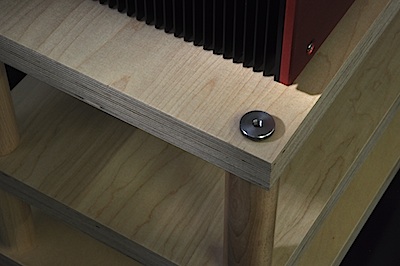
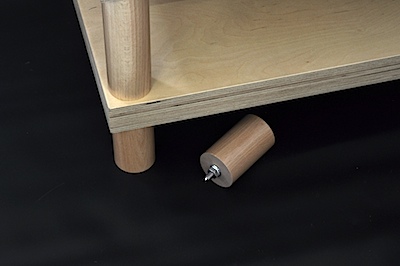
NEWS 2013 : The new and improved version of Lavardin Technologies hifiracks is now available under the brand name K-rak
K-rak by Lavardin Technologies K-rak UNO et K-rak DUO
These racks are hand made for us by the best woodwork experts in the "Pays Basque" and the "Anjou". Nothing exotic. They weight much, 38Kg for 4 tears, they are made of true high quality materials and cost more than traditional hightech hifi stands using glass, metal tubes, carbon fiber, aluminimum or assembled solid wood bits ...
They look simple, in the purest Form Follows Function tradition and there is no mad science behind, they are the result of 15 years of experience and hundreds experiments to make any good components to sound at its best.
Ask for a trial and compare with the hifi racks around: results are amazing !
Should I use cones, rubber feet or springs under components ?
It seems every body has forgoten about the story. In the late 70's when Gilles Millot (famous speaker and driver designer) first presented spikes under speakers, the tip was facing a wooden floor.... The spike is only one part of the system : the part that is easy to sell and ship .... Spikes and cones tips must face a damping / spreading material like plywwod. Then, only can the spikes behave as a "large bandwidth" and "omnidirectional emitter" of energy in the dissipating material, thus allowing minimum energy return to the component through the spikes. Only if you have a thick plywood plinth under components, it is worth to try what happens with cones or spikes. Most of the rubber feet, springs or inflating devices are no useless for quality : mostly good enough to provide a less disturbing sound balance in a poor sounding system.
Does plywood also improve speaker's balance and micro-dynamic ?
The problem is very much the same as with components. The difference is that some parts of the speakers actually generate vibrations. For the same reasons, decoupling materials should be rigid and damping to allow spreading of the vibration's energy. Again the best material is plywood... A good thick plinth of plywood where to spike a floorstander speaker is a must. Additionally, spikes won't scratch the floor any more. Same applies under stands of bookshelf speakers. Additionaly, one can put plinths on top of each stand. If speakers are also on spikes, it can be also interesting to keep the spikes under the speakers ....
There is only 3 feet under Lavardin Technologies amplifiers. Why ?
3 feet is the guaranty that each foot will receive a constant pressure what ever is the flatness of the support. With 4 feet and a non perfectly flat support, one foot can remain unloaded. They are made of specific hard neoprene rubber to allow at least good results even in the most adverse environment.
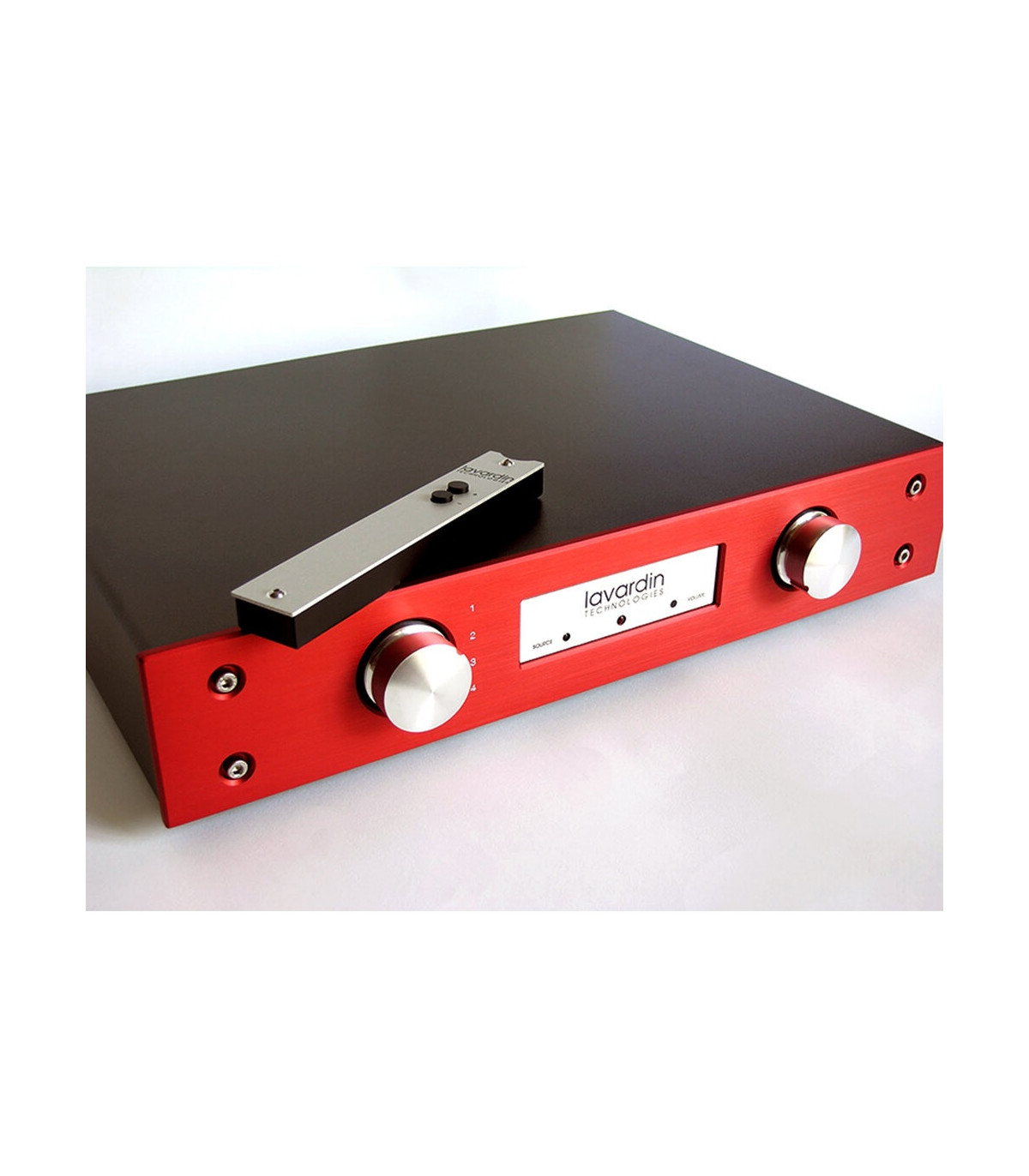














![Heed Audio Asterisk Integrated Amplifier [2nd hand]](https://www.playstereo.com/23652-home_default/heed-audio-asterisk-integrated-amplifier-2nd-hand-.jpg)
![Heed Audio Asterisk Integrated Amplifier [2nd hand]](https://www.playstereo.com/img/p/en-default-home_default.jpg)
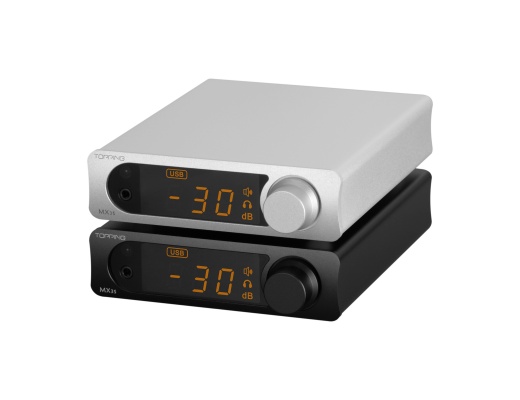
![Rogers E40 A Integrated Amplifier [used]](https://www.playstereo.com/23971-home_default/rogers-e40-a-integrated-amplifier-used-.jpg)
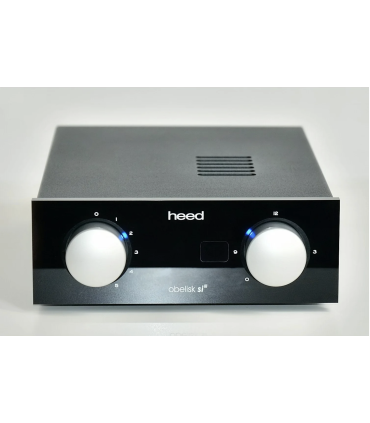
![Topping MX5 Amplifier Merus MA12070 Class D NFCA XMOS Bluetooth aptX HD [b-Stock]](https://www.playstereo.com/19456-home_default/topping-mx5-amplifier-merus-ma12070-class-d-nfca-xmos-bluetooth-aptx-hd-b-stock-.jpg)
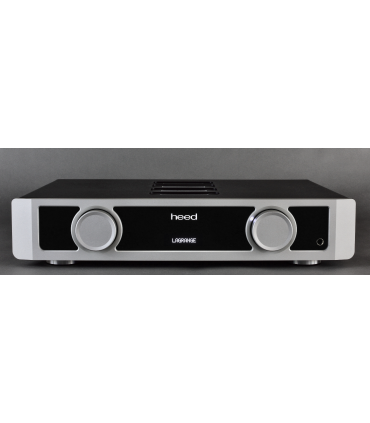
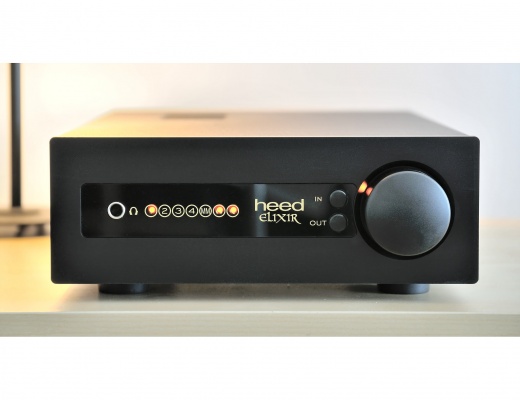
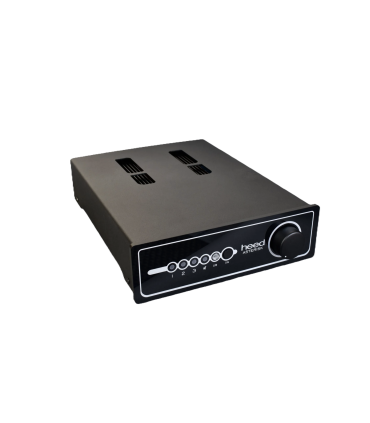
![McIntosh MA5300 Integrated Amplfier [2nd hand]](https://www.playstereo.com/23445-home_default/mcintosh-ma5300-integrated-amplfier-2nd-hand-.jpg)
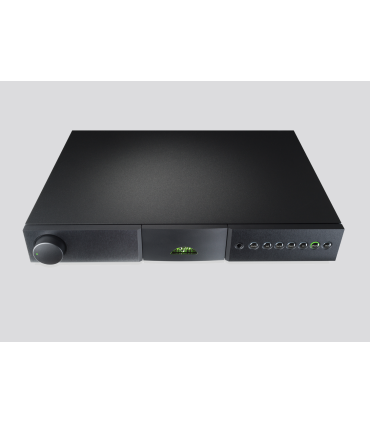
![Naim Nait 50th Anniversary Integrated Amplifier [2nd hand]](https://www.playstereo.com/22444-home_default/naim-nait-50th-anniversary-integrated-amplifier-2nd-hand-.jpg)
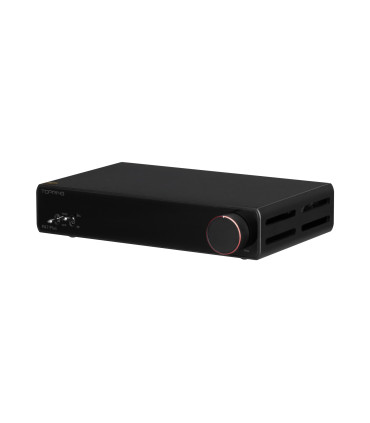
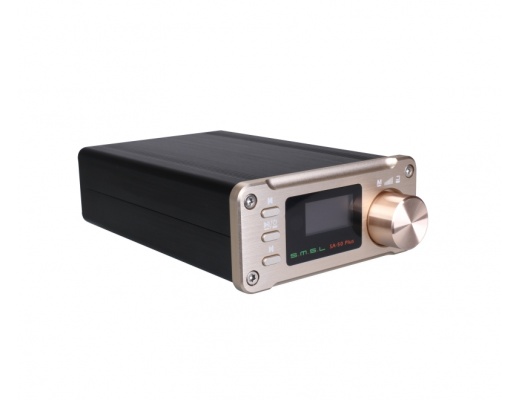
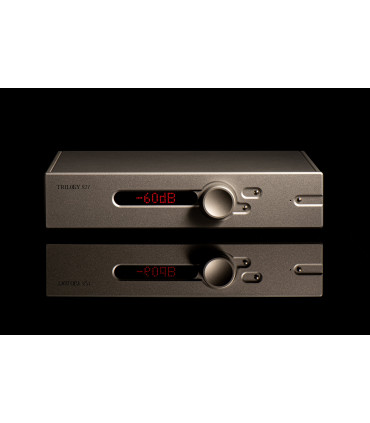

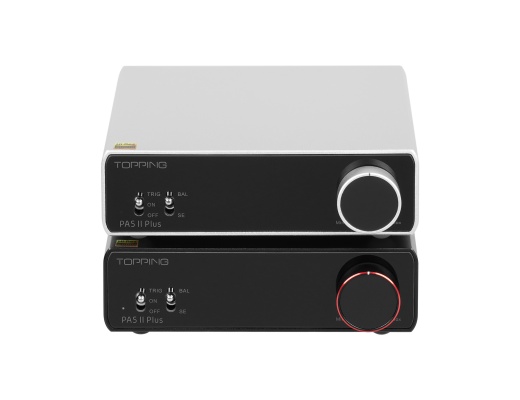


















Leave a review